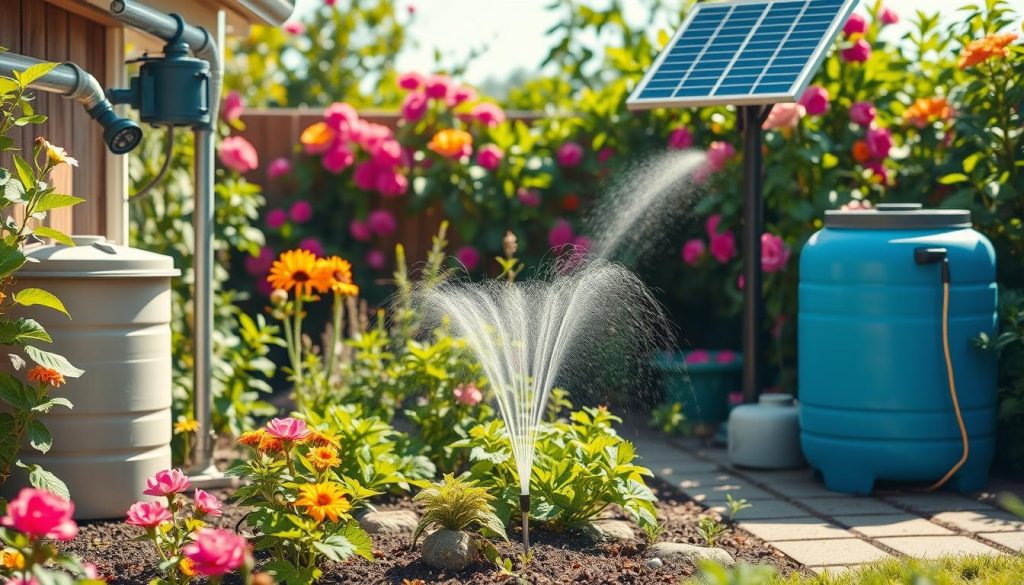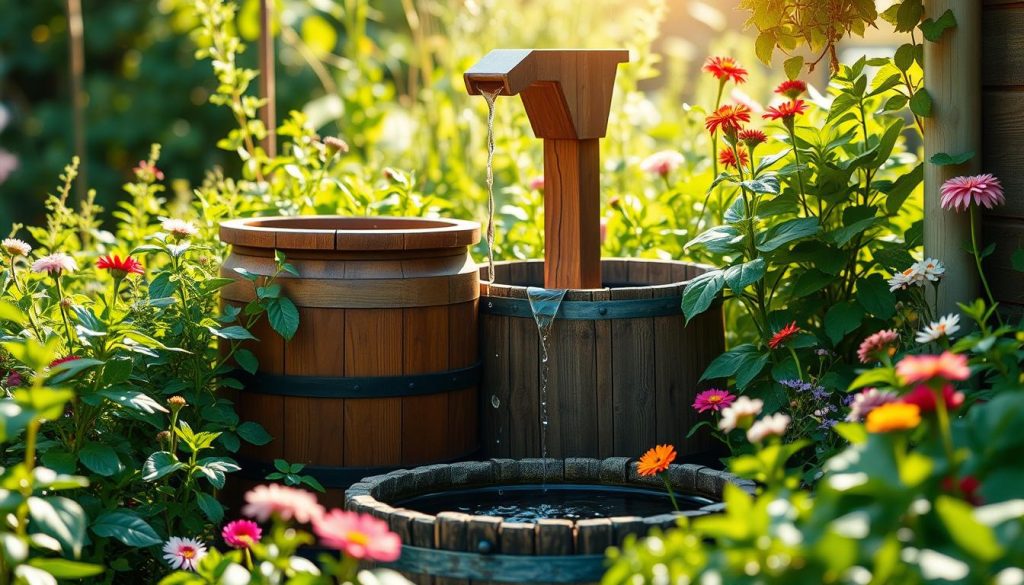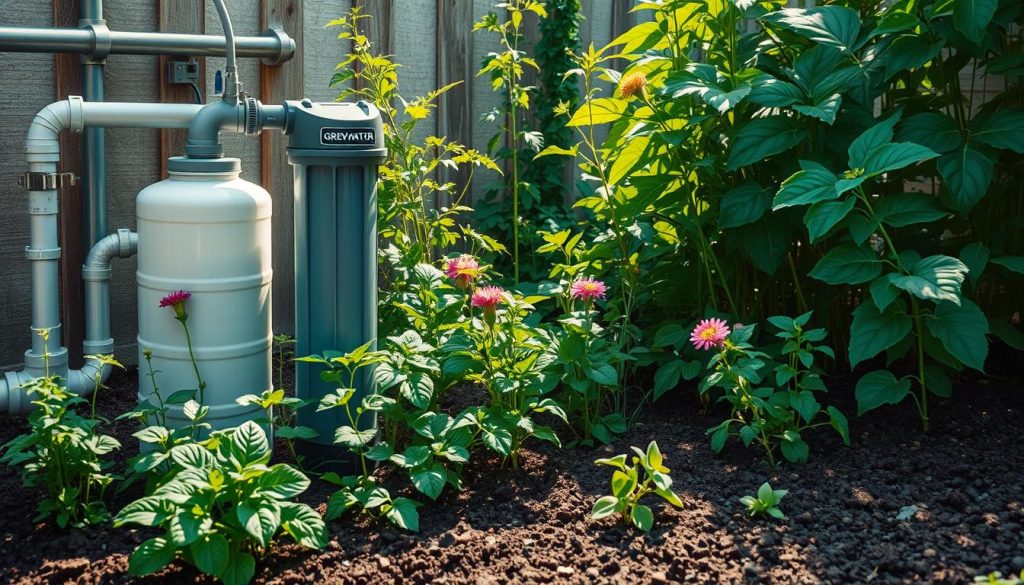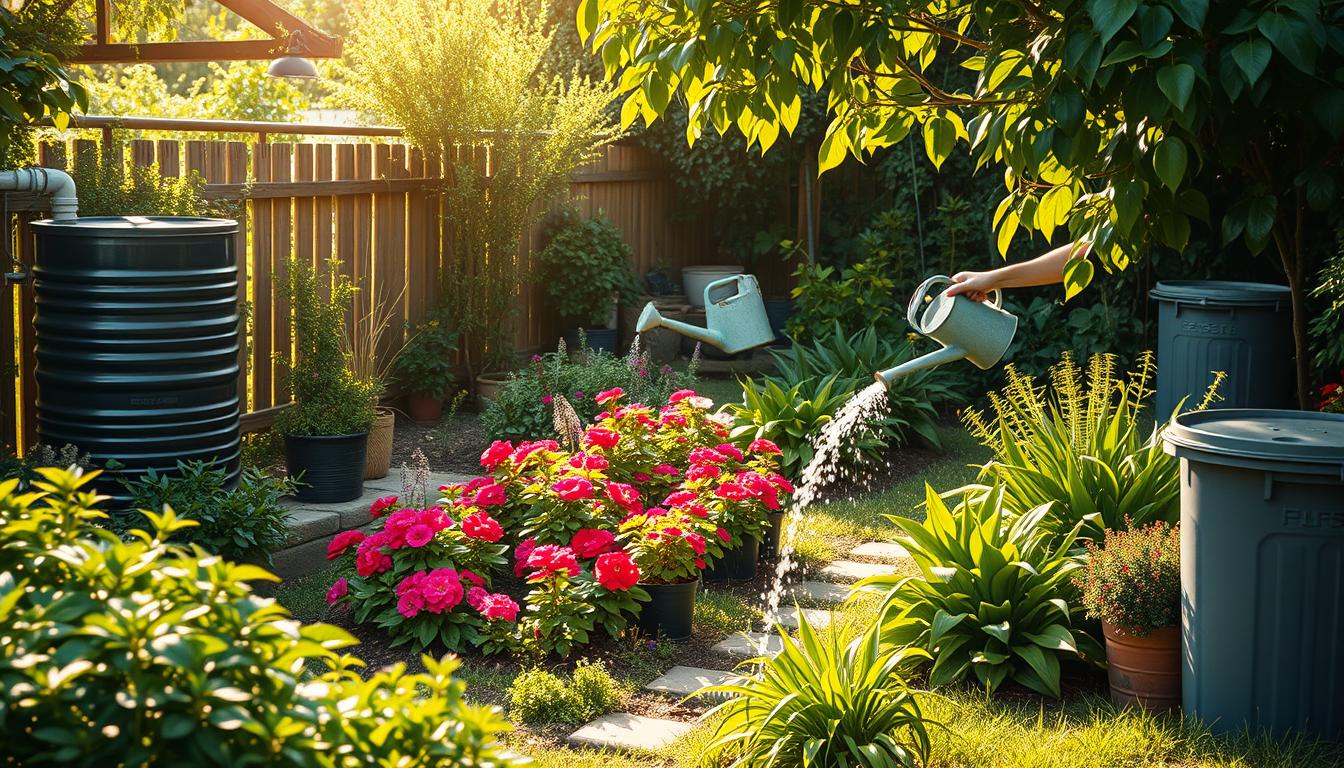As a gardener, I’m excited to share how to water plants well and save water. Using eco-friendly and water-wise methods, you can make your garden beautiful and green. I’ve learned a lot about efficient watering and I’m here to share it with you.
Water-saving tips are key for keeping our planet healthy. The EPA says using water wisely can save a lot of water. By following these tips, you can help the environment a lot.
Water-wise gardening can cut down your water use and make your garden flourish. In this article, I’ll give you my best tips for a sustainable garden. Let’s start your journey to a greener garden together.
Understanding Your Garden’s Water Needs
To make your garden thrive, knowing its water needs is key. Using green irrigation methods saves water and cuts down on waste. It’s important to check your garden’s soil type and how well it holds water. For example, clay soil holds more water than sandy soil, so you’ll need to water differently.
Water conservation in your garden is good for the planet and your wallet. Using tips like drought-resistant plants and mulching can lower your water use. Here are some important things to think about for your garden’s water needs:
- Soil type: Different soils hold water differently, so knowing your soil type helps you water right.
- Plant water requirements: Each plant needs a specific amount of water, so research your plants’ needs.
- Seasonal considerations: Weather and temperature changes affect your garden’s water needs, so adjust your watering schedule.
By understanding your garden’s water needs and using green irrigation, you can have a sustainable garden. Always aim to conserve water to protect the environment and save money.
Watering Methods That Conserve Resources
As a gardener, I’m always searching for ways to cut down on water waste. I want to make my garden more sustainable. Using eco-friendly watering methods is key. This includes drip irrigation and soaker hoses, which send water straight to the roots.
This approach cuts down on evaporation and runoff. It’s a smart way to water my plants.
Some of my top choices for watering are:
- Drip irrigation: This method delivers water right to the roots, cutting down on evaporation and runoff.
- Soaker hoses: These hoses have tiny holes that let water seep out slowly, giving plants a steady water supply.
- Hand-watering: This lets me focus on specific plants and avoid overwatering.
These methods help me create a garden that uses water wisely. Adding drought-resistant plants also cuts down on water needs. It’s all about finding the right balance to keep my plants healthy without wasting water.
Choosing the right watering method is crucial. It helps me save water and reduce my impact on the environment. Sustainable watering solutions are essential for a greener garden.

Best Times to Water My Garden
As a gardener, I’ve learned that timing is everything. Using sustainable garden watering tips helps me water my plants better. Watering in the early morning or evening reduces evaporation and runoff. This is key to avoiding water waste.
Watering at these times also helps me use water-wise gardening techniques. This way, I make the most of my watering routine.
When it comes to environmentally friendly irrigation methods, timing is crucial. Here are some key considerations:
- Watering in the early morning allows the plants to absorb the water throughout the day, reducing evaporation and runoff.
- Watering in the evening helps the plants absorb the water overnight, reducing evaporation and runoff.
- Avoiding midday watering prevents water waste, as the sun’s intense heat can cause the water to evaporate quickly.
By following these tips and using water-wise gardening techniques, I create an environmentally friendly irrigation system.
Early Morning vs. Evening Watering
Both early morning and evening watering have their benefits. The best time for me depends on my garden’s specific needs. I consider the weather forecast and my plants’ water requirements to decide when to water.
Avoiding Midday Watering Pitfalls
Midday watering can harm my garden. The intense heat causes water to evaporate quickly, leaving plants thirsty. By avoiding midday watering, I prevent water waste and ensure my plants get the water they need.
Utilizing Rainwater Harvesting
Rainwater harvesting is a simple and effective way to reduce water waste. It creates a sustainable gardening practice. By collecting rainwater, I can reduce stormwater runoff and provide a free source of water for my garden.
This eco-friendly watering practice is not only good for the environment. It also helps me conserve water in the garden.
To get started with rainwater harvesting, I need to set up a rain barrel. This can be as simple as placing a large container under my downspout to collect rainwater. I can then use this water to irrigate my plants, reducing my reliance on municipal water supplies.
By using green gardening tips like this, I can create a beautiful and thriving garden. I can also conserve water.
Benefits of Collecting Rainwater
- Reduces stormwater runoff and prevents erosion
- Provides a free source of water for gardening
- Helps conserve water in the garden and reduce water waste
By incorporating rainwater harvesting into my gardening routine, I can make a positive impact on the environment. I can also create a beautiful and sustainable garden. This eco-friendly watering practice is just one of the many green gardening tips I use to conserve water and reduce my environmental footprint.

Mulching: A Key to Water Conservation
Exploring sustainable watering solutions, I found mulching key for water saving. It reduces evaporation, stops weeds, and keeps soil temperature right. This simple step is vital for a water-saving garden, helping it grow well with less waste.
Choosing the right mulch is important. I look at the plants and climate. Wood chips, bark, and straw are good choices. They keep soil moist, cutting down on watering and protecting plants from dry spells. Mulching makes my garden water-efficient and promotes healthy plants.
Benefits of Mulching
- Reduces evaporation and retains soil moisture
- Prevents weed growth and minimizes competition for water
- Regulates soil temperature, promoting healthy root development
Mulching is a big part of my eco-friendly garden care. It helps my garden save water and supports drought-resistant plants. With the right mulch and planning, my garden is beautiful, sustainable, and easy to care for.
Implementing Greywater Systems
I’m excited to share tips on using greywater systems for your garden. These systems reuse water from sinks, showers, and washing machines. They’re a key part of water-wise gardening.
Understanding how to use greywater can help your garden thrive. You can collect it in various ways. For example:
- Installing a greywater diversion device to redirect water from your sink or shower
- Using a bucket to collect water from your washing machine
- Creating a greywater collection system using a tank or barrel
These methods save water that would otherwise be wasted. They make your garden more sustainable. By using greywater, you can cut down on water use and create a greener garden.

When setting up your greywater system, think about your garden’s needs. With some creativity and planning, you can make a system that saves water and helps the environment.
Native Plants and Drought Resistance
I’ve learned how important native plants are for my garden. They help me save water and make my garden more drought-resistant. This is a big part of being eco-friendly and using green gardening tips.
Native plants are made for the local climate and soil. This means they need less water and can handle drought better. By picking these plants, I use less water and help the environment. It’s a key part of eco-friendly gardening.
Why I Choose Native Species
I like native plants because they’re easy to care for. They fit right into the local climate and soil. Plus, they help local wildlife by providing food and shelter.
By choosing native plants, I make my garden better for the environment. It saves water and supports local life. It’s a win-win for my garden and the planet.
How Native Plants Reduce Water Needs
Native plants are great at saving water. They have deep roots to find water deep in the soil. This means they need less watering.
They’re also good at surviving with little water. This makes them drought-resistant and water-efficient. Adding them to my garden helps me use less water and care for the environment.
- Reduced watering needs
- Improved drought resistance
- Increased biodiversity and ecosystem health
By using green gardening tips and native plants, I create a beautiful, sustainable garden. It saves water and helps the local environment. This way, I make a positive difference and enjoy a healthy garden.
Monitoring and Adjusting My Watering Routine
Keeping an efficient watering routine is key for a lush, drought-resistant garden. I watch the weather and use the right tools to make smart watering choices. This helps me save water and keep my garden looking great.
Using a rain gauge to track rainfall and a soil moisture meter to check the soil’s dryness is crucial. These tools help me know when and how much to water. This way, I can adjust my watering to keep my garden healthy and green, all while saving water.

